Portrait
A portrait is a painting, photograph, sculpture, or other artistic representation of a person, in which the face and its expression is predominant. The intent is to display the likeness, personality, and even the mood of the person. For this reason, in photography a portrait is generally not a snapshot, but a composed image of a person in a still position. A portrait often shows a person looking directly at the painter or photographer, in order to most successfully engage the subject with the viewer.
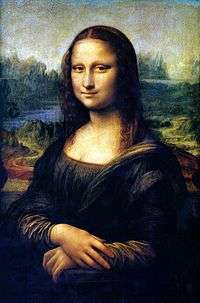
History
Prehistorical portraiture
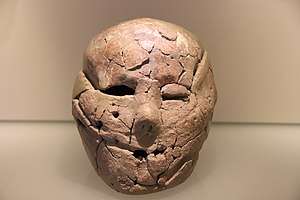
Plastered human skulls were reconstructed human skulls that were made in the ancient Levant between 9000 and 6000 BC in the Pre-Pottery Neolithic B period. They represent some of the oldest forms of art in the Middle East and demonstrate that the prehistoric population took great care in burying their ancestors below their homes. The skulls denote some of the earliest sculptural examples of portraiture in the history of art.[3]
Historical portraiture

Most early representations that are clearly intended to show an individual are of rulers, and tend to follow idealizing artistic conventions, rather than the individual features of the subject's body, though when there is no other evidence as to the ruler's appearance the degree of idealization can be hard to assess. Nonetheless, many subjects, such as Akhenaten and some other Egyptian pharaohs, can be recognised by their distinctive features. The 28 surviving rather small statues of Gudea, ruler of Lagash in Sumeria between c. 2144–2124 BC, show a consistent appearance with some individuality, although it is sometimes disputed that these count as portraits.[4]
Some of the earliest surviving painted portraits of people who were not rulers are the Greco-Roman funeral portraits that survived in the dry climate of Egypt's Fayum district. These are almost the only paintings from the classical world that have survived, apart from frescos, though many sculptures and portraits on coins have fared better. Although the appearance of the figures differs considerably, they are considerably idealized, and all show relatively young people, making it uncertain whether they were painted from life.
The art of the portrait flourished in Ancient Greek and especially Roman sculpture, where sitters demanded individualized and realistic portraits, even unflattering ones. During the 4th century, the portrait began to retreat in favor of an idealized symbol of what that person looked like. (Compare the portraits of Roman Emperors Constantine I and Theodosius I at their entries.) In the Europe of the Early Middle Ages representations of individuals are mostly generalized. True portraits of the outward appearance of individuals re-emerged in the late Middle Ages, in tomb monuments, donor portraits, miniatures in illuminated manuscripts and then panel paintings.
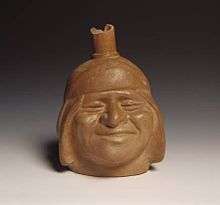
Moche culture of Peru was one of the few ancient civilizations which produced portraits. These works accurately represent anatomical features in great detail. The individuals portrayed would have been recognizable without the need for other symbols or a written reference to their names. The individuals portrayed were members of the ruling elite, priests, warriors and even distinguished artisans.[5] They were represented during several stages of their lives. The faces of gods were also depicted. To date, no portraits of women have been found. There is particular emphasis on the representation of the details of headdresses, hairstyles, body adornment and face painting.
One of the best-known portraits in the Western world is Leonardo da Vinci's painting titled Mona Lisa, which is a painting of Lisa del Giocondo. What has been claimed as the world's oldest known portrait was found in 2006 in the Vilhonneur grotto near Angoulême and is thought to be 27,000 years old.[6][7]
Self-portraiture
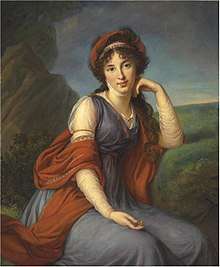
When the artist creates a portrait of themself, it is called a self-portrait. Identifiable examples become numerous in the late Middle Ages. But if the definition is extended, the first was by the Egyptian Pharaoh Akhenaten's sculptor Bak, who carved a representation of himself and his wife Taheri c. 1365 BC. However, it seems likely that self-portraits go back to the cave paintings, the earliest representational art, and literature records several classical examples that are now lost.
Official portrait
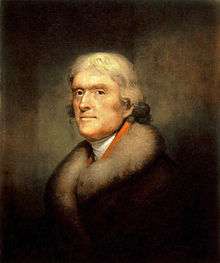
The official portrait is a photographic production of record and dissemination of important personalities, notably kings, presidents and governors. It is usually decorated with official colors and symbols such as flag, presidential stripes and coat of arms of countries, states or municipalities. There is also connotation as an image of events, products and meetings.[8]
Portrait photography
Portrait photography is a popular commercial industry all over the world. Many people enjoy having professionally made family portraits to hang in their homes, or special portraits to commemorate certain events, such as graduations or weddings.
.jpg)
Since the dawn of photography, people have made portraits. The popularity of the daguerreotype in the middle of the 19th century was due in large part to the demand for inexpensive portraiture. Studios sprang up in cities around the world, some cranking out more than 500 plates a day. The style of these early works reflected the technical challenges associated with 30-second exposure times and the painterly aesthetic of the time. Subjects were generally seated against plain backgrounds and lit with the soft light of an overhead window and whatever else could be reflected with mirrors.
As photographic techniques developed, an intrepid group of photographers took their talents out of the studio and onto battlefields, across oceans and into remote wilderness. William Shew's Daguerreotype Saloon, Roger Fenton's Photographic Van and Mathew Brady's What-is-it? wagon set the standards for making portraits and other photographs in the field.
Some photographers took the technique to other countries. Augustus Washington moved to Monrovia, Liberia from Hartford, Connecticut and created daguerreotype portraits for many political leaders for the country.
African American Portraiture
Frederick Douglass was the most photographed African American of the 19th century.[9] His iconic daguerreotypes have become symbols for the advancements of African Americans since the end of slavery.[10]
In 1920, Florenstine Perrault Collins opened a portrait shop in New Orleans Louisiana as one of only 101 African American women photographers in America at the time.[11]
Politics
In politics, portraits of the leader are often used as a symbol of the state. In most countries it is common protocol for a portrait of the head of state to appear in important government buildings. Excessive use of a leader's portrait, such as that done of Joseph Stalin, Adolf Hitler, or Mao Zedong, can be indicative of a personality cult.
Literature
In literature the term portrait refers to a written description or analysis of a person or thing. A written portrait often gives deep insight, and offers an analysis that goes far beyond the superficial. For example, American author Patricia Cornwell wrote a best-selling book entitled Portrait of a Killer about the personality, background, and possible motivations of Jack the Ripper, as well as the media coverage of his murders, and the subsequent police investigation of his crimes.
However in Literature a portrait of a character is a subtle combination of fact and fiction, exploring the individual psychology of the character in the wider context of their environment. When the subject of the narrative is a historical figure, then the writer is free to create a compelling and dramatic portrait of the person that draws on imaginative invention for verisimilitude. An example is Hilary Mantel's Wolf Hall (2009) which, while acknowledging the work of the historian Dr Mary Robertson for background information, imagines an intimate portrait of Oliver Cromwell and his intense relationship with Henry VIII at a critical time in English history. It could be argued that in literature any portrait is a discreet assembly of facts, anecdotes, and author's insights. Plutarch's Lives, written in the 2nd century AD, offer a prime example of historical literary portraits, as a source of information about the individuals and their times.
Painted portraits can also play a role in literature. These can be fictional portraits, such as the portrait of Dorian Gray in the eponymous novel by Oscar Wilde. But sometimes also real portraits feature in literature. An example is the portrait of Richard III that plays a role in Josephine Tey's The Daughter of Time.[12]
See also
- Caricature
- Environmental portrait
- Head shot
- Hidden faces
- Hierarchy of genres
- Painting the Century: 101 Portrait Masterpieces 1900–2000
- Portrait painting
- Self-portrait
- The Portrait Now
- The Portrait of a Lady, a novel published in 1881 and a film in 1996
- Royal Society of Portrait Painters
References
- CAHN, HERBERT A.; GERIN, DOMINIQUE (1988). "Themistocles at Magnesia". The Numismatic Chronicle (1966-). 148: 20 & Plate 3. JSTOR 42668124.
- Tanner, Jeremy (2006). The Invention of Art History in Ancient Greece: Religion, Society and Artistic Rationalisation. Cambridge University Press. p. 97. ISBN 9780521846141.
- Kleiner, Fred S. (2012). Gardner's Art through the Ages: Backpack Edition. Cengage Learning. p. 42. ISBN 9780840030542.
- Winter, Irene (2009). "What/When is a portrait?". Proceedings of the American Philosophical Society. 153.
- Donnan, Christopher B. Moche Portraits from Ancient Peru University of Texas Press, 2004. ISBN 0-292-71622-2.
- Jones, Jonathan (6 June 2006). "Old masters". The Guardian. London.
- Sage, Adam (5 June 2006). "Cave face 'the oldest portrait on record'". The Times. London. Archived from the original on July 24, 2008. Retrieved 2008-01-04.
- Portuguese Almanac of Photography, 1957 edition, Mário Nogueira. Lisbon, Portugal, 1957
- Gates, Henry Louis (September 2015). "Frederick Douglass's Camera Obscura: Representing the Antislave "Clothed and in Their Own Form"". Critical Inquiry. 42 (1): 31–60. doi:10.1086/682995. ISSN 0093-1896.
- Westerbeck, Colin L. (1999). "Frederick Douglass Chooses His Moment". Art Institute of Chicago Museum Studies. 24 (2): 145–262. doi:10.2307/4112966. ISSN 0069-3235. JSTOR 4112966.
- Anthony, Arthé A. (2002). "Florestine Perrault Collins and the Gendered Politics of Black Portraiture in 1920s New Orleans". Louisiana History: The Journal of the Louisiana Historical Association. 43 (2): 167–188. ISSN 0024-6816. JSTOR 4233837.
- Friend, Stacie "Real Portraits in Literature" (2020). Maes, Hans (ed.). Portraits and Philosophy. Routledge.
External links
| Look up portrait in Wiktionary, the free dictionary. |
| Look up portraiture in Wiktionary, the free dictionary. |
| Look up portraitist in Wiktionary, the free dictionary. |
| Wikimedia Commons has media related to Portraits. |
- How to Draw Faces, a how-to article from wikiHow
- Digitaler Portraitindex
- National Portrait Gallery of the Smithsonian Institution
- National Portrait Gallery London
- National Portrait Gallery Moscow
- Painting The Century 101 Portrait Masterpieces
- Jeanne Ivy's Self-Portrait Page - What Artists Find When They Search in the Mirror.
- Portrait Detectives - Fun interactive introduction to the analysis of portraiture.
- Reportret - A gallery of reconstructions of missing portraits from world history.
- Royal Society of Portrait Painters
- The oldest portrait in the world
- The oldest known portrait in the world
- Royal Society of Portrait Painters
